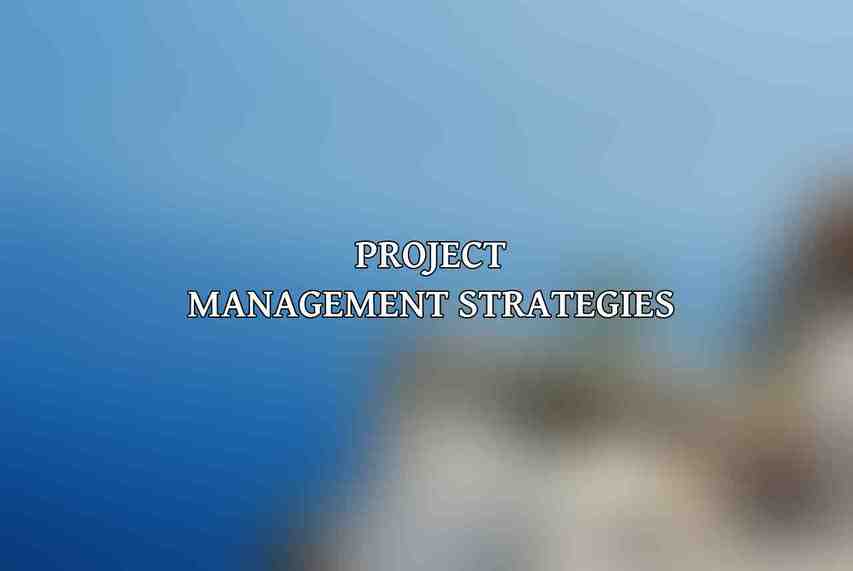Effective communication is the cornerstone of successful collaboration within a team. By implementing various communication strategies, teams can work together more efficiently and harmoniously.
Active Listening

Active listening is a fundamental aspect of effective communication. It involves not just hearing but truly understanding what others are conveying.
- Pay undivided attention: Giving your full attention to the speaker helps in understanding their perspective.
- Ask clarifying questions: Seeking clarification ensures that you have a clear understanding of the message.
- Summarize and reflect: Summarizing what you’ve heard and reflecting it back to the speaker validates understanding and promotes further clarity.
Clear and Concise Communication
Clear and concise communication helps avoid misunderstandings and ensures that everyone is on the same page.
- Use straightforward language: Avoiding unnecessary complexity in communication makes it easier for everyone to grasp the message.
- Avoid jargon and acronyms: Using simple, easy-to-understand terms prevents confusion among team members.
- Be specific and provide context: Offering adequate context with information helps in conveying the complete message.
Open and Transparent Communication
Openness and transparency create a culture of trust within a team, leading to more effective collaboration.
- Share information openly: Keeping everyone informed fosters a sense of inclusivity and involvement.
- Encourage feedback and discussion: Promoting feedback encourages a culture of continuous improvement and innovation.
- Address conflicts constructively: Dealing with conflicts openly and constructively helps in resolving issues efficiently.
Effective Team Meetings
Well-structured team meetings are essential for aligning on goals, discussing progress, and making decisions.
- Establish clear agendas: Having a defined agenda ensures that meetings stay focused and productive.
- Facilitate active participation: Encouraging participation from all team members promotes engagement and idea sharing.
- Follow up on decisions: It’s critical to follow through on action items and decisions made during meetings to maintain progress.
Technology for Communication
utilizing technology for communication is key to enabling seamless and efficient collaboration in teams.
- Email: Using clear subject lines and assigning tasks in emails helps in organizing communication.
- Instant Messaging: Real-time communication through platforms like Slack enables quick updates and easy information sharing.
- Video Conferencing: Platforms like Zoom facilitate remote collaboration with face-to-face interactions, bridging geographical gaps.
Project Management Strategies

Effective project management is vital for coordinating team efforts towards common goals and ensuring project success.
Clear Goal Setting
Setting clear and achievable goals establishes a roadmap for the team to follow throughout the project lifecycle.
- Define project objectives: Clearly outlining what the project aims to achieve helps in focusing efforts.
- Establish timelines and milestones: Setting timelines and milestones creates a sense of urgency and direction.
- Assign roles and responsibilities: Clearly defining who is responsible for what tasks helps in avoiding confusion.
Task Management
Efficient task management ensures that work is organized, delegated appropriately, and completed on time.
- Use task management tools: Tools like Asana and Trello help in organizing tasks, setting priorities, and tracking progress.
- Delegate tasks and provide guidance: Delegating tasks based on team members’ strengths and offering necessary guidance ensures smooth task completion.
- Track progress and adjust as needed: Regularly monitoring progress allows for early identification of bottlenecks and adjustments to plans.
Collaboration Tools
Utilizing collaboration tools streamlines communication, task management, and overall project coordination.
- Collaboration Platforms: Platforms like Google Workspace and Microsoft Teams offer integrated tools for communication, file sharing, and collaboration.
- Project Management Software: Tools like Jira and Basecamp help in organizing tasks, tracking progress, and facilitating team communication.
- File Sharing Tools: Using tools like Dropbox and Google Drive enables seamless sharing and collaboration on project documents and files.
Effective Decision-Making
Making well-informed and collective decisions is crucial for project success and team alignment.
- Gather input from all team members: Including diverse perspectives in the decision-making process leads to more robust and informed choices.
- Use consensus-building techniques: Incorporating input from all team members and finding common ground ensures buy-in and commitment.
- Clearly communicate decisions: Transparently communicating decisions, rationale, and next steps avoids confusion and promotes alignment.
Building a Collaborative Culture
Creating a collaborative culture within a team fosters trust, respect, and a shared commitment to achieving common goals. Get the scoop on our perspective regarding Innovative Team Collaboration Techniques and Tools
Trust and Respect
Trust and respect are foundational elements of a collaborative culture that nurture positive relationships among team members.
- Foster open and honest communication: Encouraging transparent and honest communication builds trust and understanding within the team.
- Value diversity and different perspectives: Recognizing and appreciating diverse viewpoints leads to innovation and creative problem-solving.
- Recognize and appreciate contributions: Acknowledging and valuing team members’ contributions fosters a culture of appreciation and respect.
Team Values
Establishing and upholding common team values creates a cohesive and aligned work environment.
- Define and align on team values: Agreeing on shared values ensures that everyone is working towards the same principles and objectives.
- Create a supportive and inclusive environment: Encouraging support and inclusivity cultivates a positive team culture that values each member’s contributions.
- Encourage collaboration and teamwork: Promoting collaboration and teamwork reinforces the importance of working together towards common goals.
Conflict Resolution
Addressing conflicts openly and constructively is essential for maintaining a harmonious team dynamic.
- Address conflicts promptly: Dealing with conflicts as soon as they arise prevents issues from escalating and impacting team morale.
- Facilitate constructive dialogue: Encouraging respectful and constructive discussions helps in resolving conflicts effectively.
- Seek win-win solutions: Striving for mutually beneficial outcomes in conflict resolution promotes understanding and collaboration.
Team Building Activities
Engaging in team building activities fosters camaraderie, trust, and stronger working relationships within the team.
- Icebreakers and team games: Fun activities like icebreakers and games facilitate bonding and help team members get to know each other better.
- Trust exercises: Building trust through exercises promotes better communication and collaboration among team members.
- Off-site retreats: Organizing off-site retreats creates a relaxed environment for team members to bond, brainstorm, and engage in team-building activities.
Continuous Improvement Strategies
Continuously evolving and enhancing collaboration strategies is essential for sustained team success and effectiveness.
Feedback and Evaluation
Regular feedback and evaluation help in identifying areas for improvement and refining collaboration practices.
- Regularly gather feedback from team members: Seeking input from team members on collaboration processes provides valuable insights for improvement.
- Conduct team reviews to identify areas for improvement: Reviewing team performance and collaboration practices helps in pinpointing areas that need enhancement.
- Implement changes to enhance collaboration: Acting on feedback and making necessary changes ensures continuous improvement in team collaboration.
Training and Development
Investing in training and development opportunities empowers team members with the skills and knowledge necessary for effective collaboration.
- Provide training on effective collaboration techniques: Offering training on best practices in collaboration equips team members with tools for success.
- Encourage team members to participate in workshops or courses: Supporting team members in enhancing their collaboration skills through workshops and courses boosts overall team performance.
- Invest in development opportunities for leaders: Developing leadership skills among team members enhances their ability to guide and foster collaborative efforts within the team.
Measurement and Tracking
Tracking key metrics related to collaboration enables teams to assess performance, identify areas for optimization, and make data-driven decisions. Check out our insights into Team Building Activities That Enhance Collaboration
- Track key metrics related to collaboration: Measuring factors such as communication effectiveness and task completion rates helps in evaluating collaboration performance.
- Use data to identify areas for optimization: Analyzing data on collaboration metrics allows teams to pinpoint areas that require improvement.
- Make adjustments to improve effectiveness: Implementing changes based on data insights ensures that collaboration practices evolve and become more effective over time.
implementing top collaboration strategies for effective teamwork involves a combination of communication, project management, building a collaborative culture, and continuous improvement initiatives. By focusing on these key areas and leveraging best practices, teams can enhance their collaboration, productivity, and overall success in achieving shared goals and objectives.
Frequently Asked Questions
What are some common collaboration strategies for effective teamwork?
Some common collaboration strategies include clear communication, setting goals together, assigning roles and responsibilities, providing feedback, and promoting a positive team environment.
How can team members improve communication for better collaboration?
Team members can improve communication by actively listening, being clear and concise in their messages, encouraging open discussions, utilizing project management tools, and fostering trust among team members.
What role does accountability play in successful collaboration?
Accountability is essential in successful collaboration as it ensures that each team member fulfills their responsibilities, meets deadlines, and contributes to the overall success of the team. Dive deeper into Best Task Tracking Software for Team Collaboration
How can conflicts be resolved in a collaborative team setting?
Conflicts can be resolved in a collaborative team setting by addressing issues promptly, listening to all parties involved, finding common ground, seeking compromise, and focusing on finding solutions rather than placing blame.
Why is it important to celebrate achievements in a collaborative team?
Celebrating achievements in a collaborative team boosts morale, reinforces camaraderie, motivates team members, and acknowledges their hard work and contributions to the team’s success.

